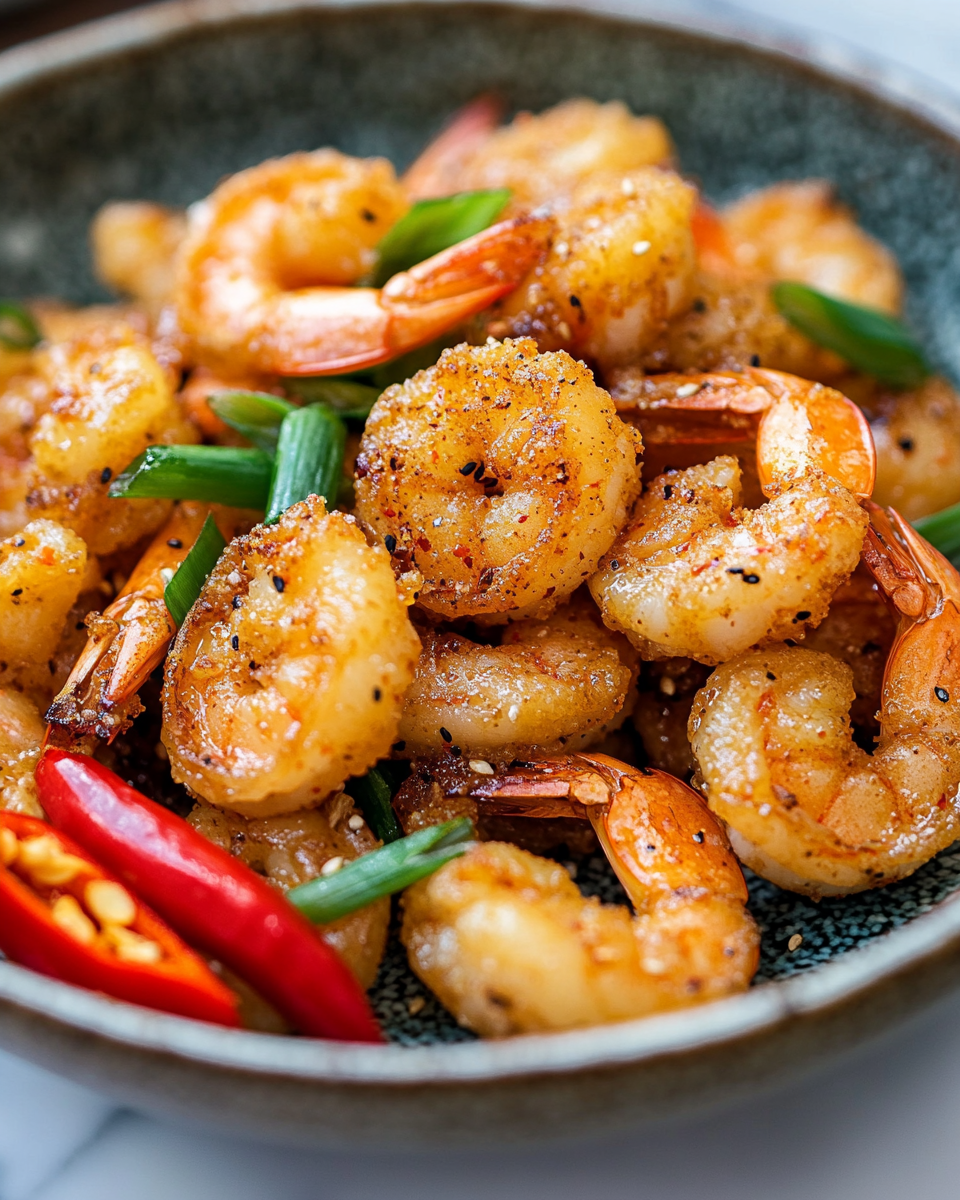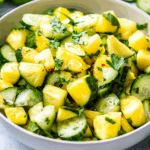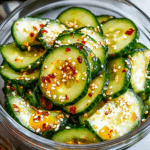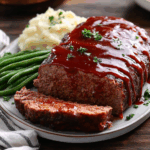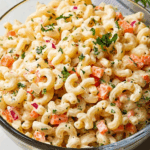This Salt and Pepper Crispy Shrimp is a bold and flavorful Asian-inspired dish that’s quick to prepare and perfect for serving as an appetizer or a light meal. Crispy fried shrimp tossed with aromatic garlic, fresh chilies, and a blend of salt and pepper make it irresistibly delicious. It’s crunchy, spicy, and packed with umami, ready in just 20 minutes!
FULL RECIPE
Ingredients
- 1 lb large shrimp, peeled and deveined (tails on)
- ½ cup cornstarch
- ½ tsp baking powder
- 1 tsp sea salt
- ½ tsp ground white pepper
- ½ tsp ground black pepper
- 1 tsp garlic powder
- 1 red chili, thinly sliced
- 1 green chili, thinly sliced
- 3 cloves garlic, finely minced
- 2 green onions, chopped
- Oil, for frying
- Lime wedges, for serving (optional)
Directions
- In a large bowl, combine cornstarch, baking powder, garlic powder, and a pinch of salt and pepper. Toss the shrimp in the dry mixture until evenly coated.
- Heat oil in a deep skillet or wok over medium-high heat. Once hot, fry the shrimp in batches for 2–3 minutes or until golden and crispy. Drain on a paper towel.
- In a clean pan, heat 1 tbsp of oil over medium heat. Sauté minced garlic, red chili, green chili, and green onions until fragrant (about 30 seconds).
- Add the fried shrimp to the pan. Sprinkle with the remaining salt, white pepper, and black pepper. Toss to combine well and coat the shrimp in the aromatic mixture.
- Serve immediately with lime wedges on the side.
Nutrition Facts
- Calories: 280
- Total Fat: 14g
- Saturated Fat: 2g
- Cholesterol: 190mg
- Sodium: 710mg
- Total Carbohydrates: 14g
- Dietary Fiber: 1g
- Sugars: 0g
- Protein: 25g
- Vitamin A: 4% DV
- Vitamin C: 20% DV
- Calcium: 6% DV
- Iron: 10% DV
The Origin and Cultural Influence of Salt and Pepper Shrimp
Salt and pepper shrimp is a dish that draws inspiration from traditional Cantonese cooking, a style known for its simple yet bold use of seasoning. Originating from Southern China, this dish has found its way into many Asian restaurants worldwide due to its addictive combination of crunchy texture and savory, spicy flavor. The technique of deep-frying shrimp and seasoning with salt, white pepper, and fresh aromatics like garlic and chili peppers embodies the balance of flavors typical of Cantonese cuisine—where freshness and texture are equally important as taste. Over time, it has been adapted with regional twists but remains a beloved appetizer in Asian-inspired menus everywhere.
Why Shrimp is the Perfect Seafood Choice
Shrimp is one of the most popular seafood choices globally, and for good reason. Its naturally sweet, delicate flavor and firm texture lend themselves well to a variety of cooking methods, especially frying. When cooked correctly, shrimp becomes tender yet maintains a satisfying bite that pairs perfectly with crispy coatings like cornstarch. Additionally, shrimp is a lean protein packed with essential nutrients such as iodine, vitamin B12, and omega-3 fatty acids, making it a nutritious option for health-conscious eaters. Its quick cooking time also makes it ideal for fast-paced cooking, which is perfect for busy home cooks or restaurant kitchens.
The Role of Cornstarch and Baking Powder in Creating Crispy Texture
The crispy texture of this dish owes much to the combination of cornstarch and baking powder in the batter. Cornstarch is a common ingredient in Asian frying recipes because it absorbs moisture and creates a light, crackly crust when fried. Baking powder acts as a leavening agent, introducing tiny bubbles into the batter that expand under heat, making the coating even crispier and less dense. This duo ensures that the shrimp’s exterior is golden and crunchy, while the inside remains juicy and tender. This contrast in textures is one of the key reasons why this dish is so popular.
Balancing Heat: The Use of Red and Green Chilies
Chilies are not only a visual garnish in salt and pepper shrimp; they play a crucial role in delivering a balanced spicy heat that complements the dish’s saltiness. Red and green chilies bring a fresh, sharp bite that wakes up the palate without overpowering the shrimp’s natural sweetness. Their heat level can be adjusted depending on personal preference, making the recipe versatile. Chilies also contain capsaicin, a compound known for its metabolism-boosting properties and ability to trigger the release of endorphins, contributing to the pleasurable eating experience.
Garlic and Green Onions: Aromatic Enhancers
The fragrant garlic and green onions used in this dish add layers of flavor that elevate the simple fried shrimp to something truly memorable. Garlic, when sautéed briefly, releases its sweet and pungent aroma, enhancing the overall savoriness of the dish. Green onions add a subtle oniony freshness and a slight crunch, balancing the richness of the fried shrimp. These aromatics are essential in Asian cooking as they help build a complex flavor profile without overwhelming the natural taste of the main ingredient.
Nutritional Benefits of Shrimp in a Fried Dish
While fried foods often get a bad rap, shrimp offers a nutritional boost that balances out the indulgence. Shrimp is high in protein but low in calories and fat, making it a great option for those watching their intake. It also provides key nutrients like selenium, an antioxidant that supports immune function, and vitamin D, important for bone health. The dish’s seasoning with black and white pepper introduces piperine, which may aid digestion and improve nutrient absorption. Eating salt and pepper shrimp in moderation can be part of a balanced diet, especially when paired with fresh sides or vegetables.
Cooking Techniques to Achieve Perfect Frying
Achieving the perfect crispy shrimp requires attention to oil temperature and frying technique. Maintaining a consistent oil temperature between 350°F and 375°F ensures the shrimp cooks quickly without absorbing excess oil. Frying in small batches prevents the oil temperature from dropping, which could result in soggy shrimp. Draining the shrimp on paper towels immediately after frying removes excess grease and keeps the coating crisp. These small techniques make a big difference in texture and flavor, elevating the dish from average to restaurant-quality.
Variations and Adaptations of Salt and Pepper Shrimp
This dish is versatile and can be easily adapted to suit different tastes and dietary needs. Some variations include adding other aromatics like ginger or using different types of seafood such as squid or scallops. For a healthier twist, the shrimp can be baked or air-fried instead of deep-fried, reducing oil usage while still achieving some crispiness. Additionally, adjusting the spice level or incorporating different peppers can customize the flavor profile to regional or personal preferences, making salt and pepper shrimp a flexible recipe suitable for many occasions.
Serving Suggestions and Pairings
Salt and pepper shrimp works beautifully as an appetizer, but it can also be served as part of a larger meal. Pairing it with steamed jasmine rice or fried rice balances the heat and saltiness, creating a well-rounded plate. A fresh cucumber salad or pickled vegetables add a refreshing contrast to the richness of the fried shrimp. Dipping sauces like sweet chili or soy-based dips can enhance the flavor further. For drinks, light beers, crisp white wines, or jasmine tea complement the bold flavors of this dish.
Tips for Using Fresh Shrimp vs. Frozen Shrimp
Using fresh shrimp yields the best texture and flavor, but frozen shrimp is a convenient and reliable alternative. When using frozen shrimp, it’s important to thaw them properly by placing them in the refrigerator overnight or rinsing under cold water before cooking. Patting shrimp dry is crucial to prevent splattering during frying and to ensure the coating sticks properly. Whether fresh or frozen, look for shrimp that is firm, translucent, and free from any strong fishy odors to guarantee freshness and quality.
Health Considerations and Moderation
While delicious, fried foods like salt and pepper shrimp should be enjoyed in moderation, especially for those mindful of heart health or calorie intake. Using healthier oils with higher smoke points, such as peanut or avocado oil, can improve the nutritional profile of fried dishes. Incorporating more vegetables alongside the shrimp can add fiber and nutrients, balancing the meal. Paying attention to portion sizes and frequency helps keep this flavorful treat part of a healthy and varied diet without overindulgence.
Conclusion
Salt and pepper crispy shrimp has stood the test of time because it perfectly combines crispy texture, bold seasoning, and fresh aromatics into a dish that appeals to many palates. Its roots in Cantonese cuisine lend authenticity, while its simplicity makes it accessible for home cooks worldwide. The balance of salty, spicy, and savory flavors keeps people coming back for more, whether as an appetizer, snack, or part of a meal. With its nutritional benefits, versatility, and ease of preparation, salt and pepper shrimp is a timeless recipe that continues to delight food lovers everywhere.

